KEY TAKEAWAYS
- Deforestation Fuels Water Scarcity: Forest loss disrupts hydrological cycles, reducing rainfall, groundwater, and overall water availability.
- Forests Protect Water Quality & Infrastructure: The absence of trees in a watershed leads to erosion, dam siltation, and increased water pollution, compromising water quality and storage.
- Key deforestation drivers such as Agriculture, logging, urbanization, poverty, and weak governance are driven by socio-economic pressures.
- To sustain water resources, integrating sustainable forest management and water resource strategies through initiatives like reforestation, agroforestry, and erosion control is essential.
- Strong policy enforcement is a necessity to safeguard Nigeria’s biodiversity and raise public awareness on the impacts of deforestation.
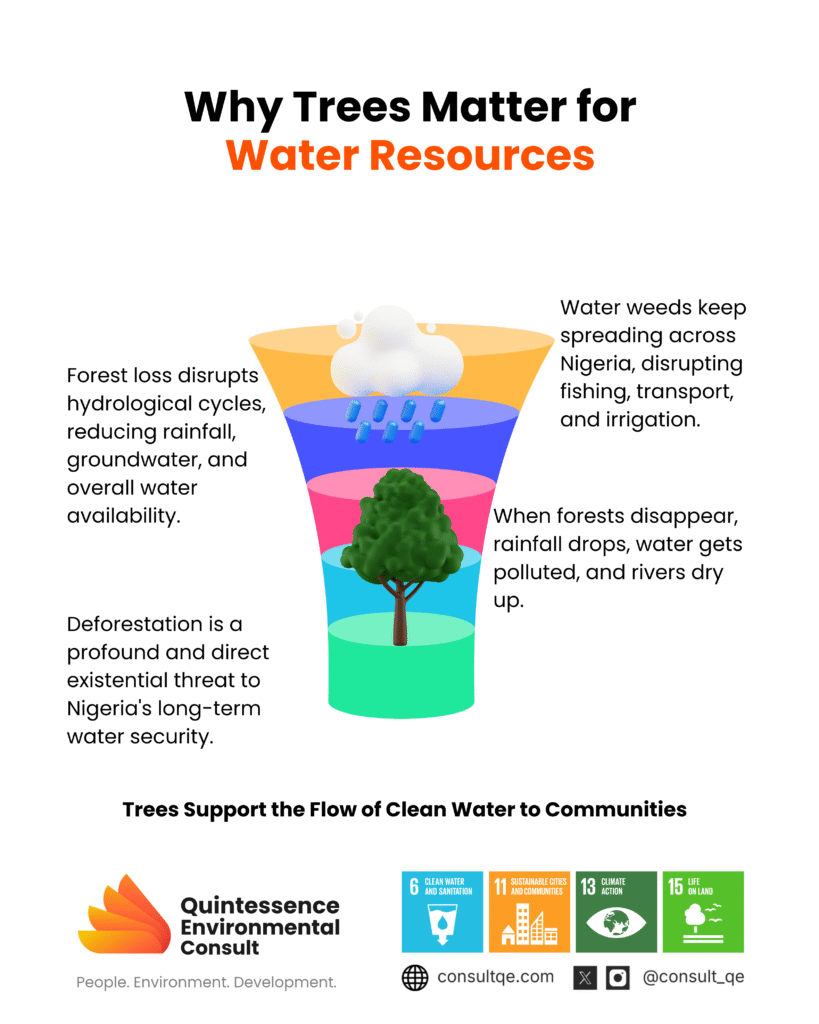
INTRODUCTION
Nigeria, a nation rich in biodiversity, is facing the challenge of water scarcity. A significant, yet often underestimated, contributor to this is deforestation.
Forest ecosystems are integral in sustaining water resources by protecting river catchments, maintaining rainfall patterns, and filtering water naturally. (10) Forests significantly enhance soil moisture retention, minimizing surface runoff, storing considerable volumes of water within their canopy, and facilitating the gradual infiltration and percolation of water into the subsurface (3).
The continuous degradation and clearing of forest reserves in the country disrupts its natural hydrological processes, jeopardizing the sustainability of freshwater resources for millions (8).
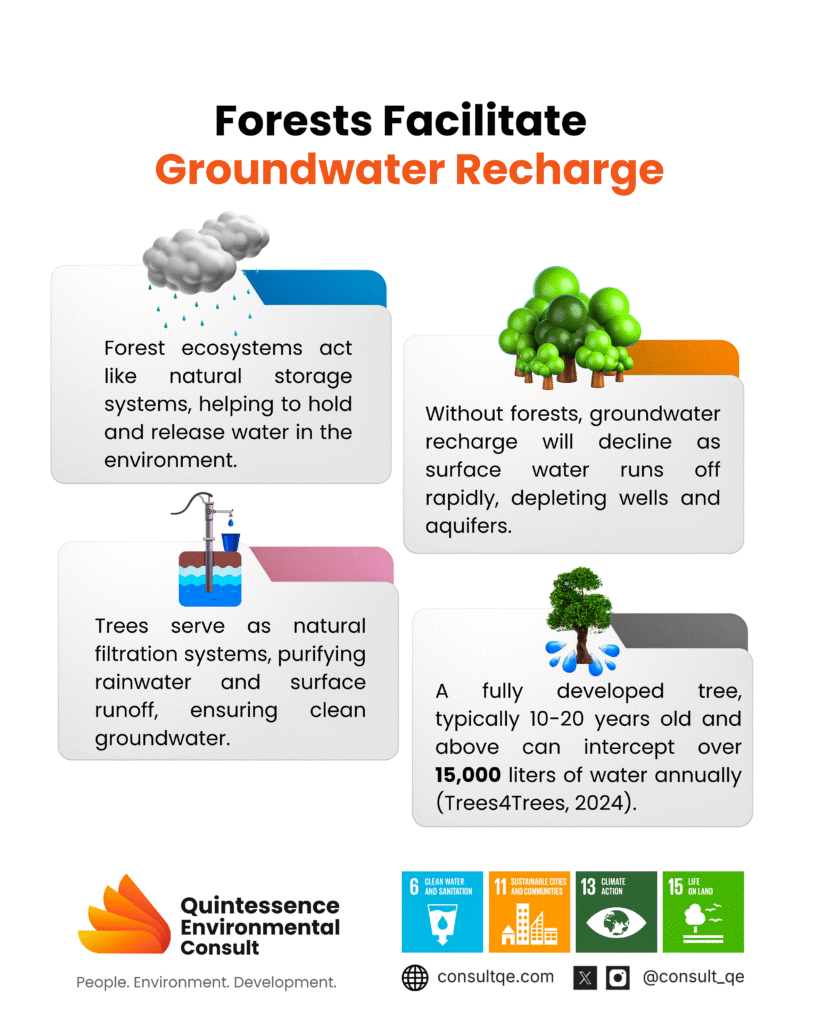
HOW DEFORESTATION AFFECTS WATER RESOURCES IN NIGERIA
- Impaired Soil Moisture Retention and Groundwater Recharge
Forests function as intricate natural sponges within the hydrological system. Mature trees typically 10-20 years old and above, can percolate over 15,000 liters of water annually into the subsurface (15). However, when forests are cleared, this natural hydrological pump weakens, leading to a reduction in atmospheric moisture and a subsequent decline in groundwater recharge . This disruption can intensify dry seasons, drought conditions, and alter the spatial & temporal distribution of rainfall, particularly impacting rain-fed agriculture and traditional water harvesting systems. (5)
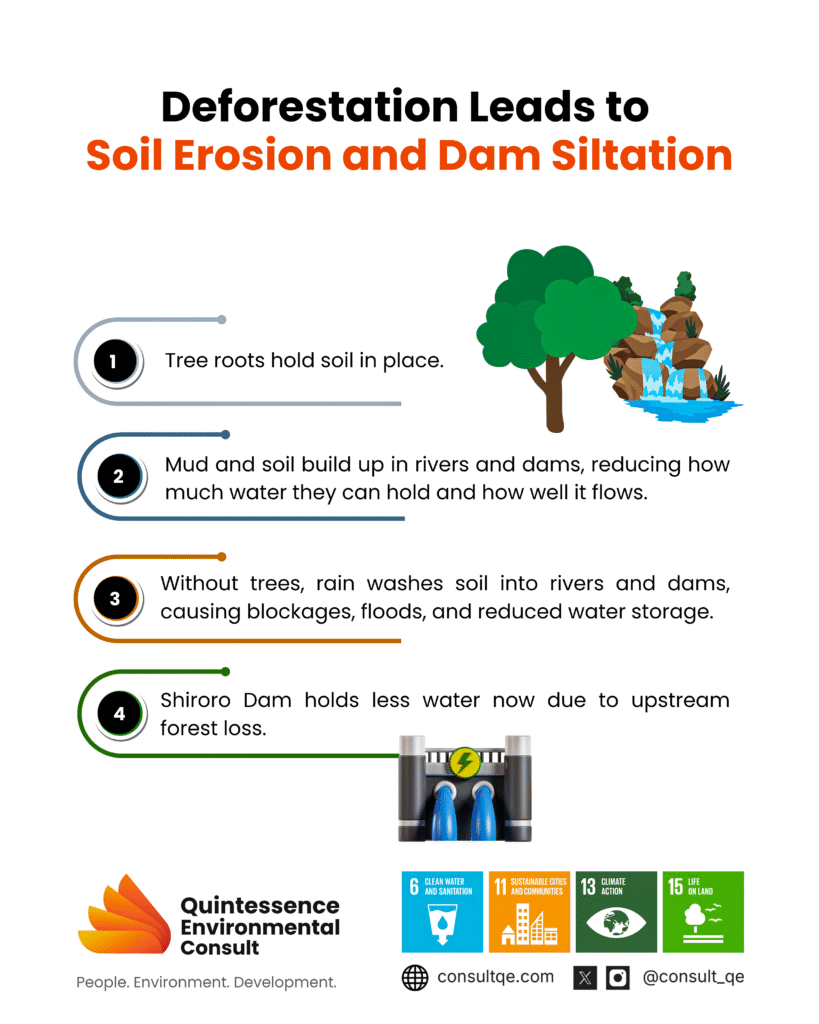
- Erosion and Sedimentation Clogging Our Rivers and Dams
The absence of trees makes the topsoil highly susceptible to erosional processes, transporting the loose soil into rivers, streams, and dams. (12) Over time, the sediments build up and clog the surrounding water bodies, making them shallow and difficult to store water(11). A compelling case study is the Shiroro Dam in Niger State, a pivotal national asset for hydroelectric power generation and agricultural irrigation. This dam has experienced considerable siltation due to upstream erosion originating from degraded forestlands within its catchment area. This has resulted in a reduced storage capacity, leading to frequent water shortages that impair electricity generation and agricultural productivity in the surrounding region.(1)
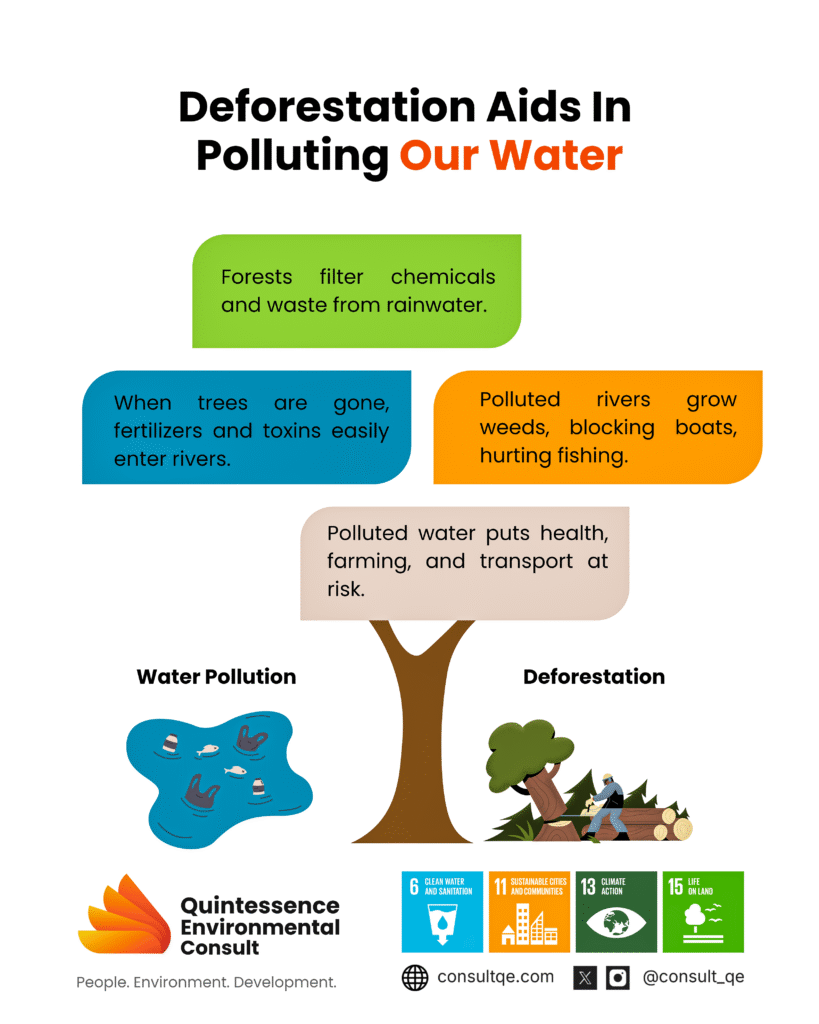
- Deforestation significantly contributes to water pollution
Forests serve as natural filtration systems, purifying rainwater and surface runoff before it enters major rivers and groundwater reservoirs. The removal of these natural filters compromises the ecosystem’s capacity to attenuate pollutants. Agricultural runoff containing fertilizers, pesticides, and other xenobiotic chemicals can flow unimpeded into water bodies, rendering them unsuitable for potable use and irrigation. (13) A national survey conducted in the year 2000 indicated that over 30 of Nigeria’s 36 states, including the Federal Capital Territory, were afflicted by infestations of water hyacinth (Eichhornia crassipes) (10). Water hyacinth has seriously impacted critical water bodies such as Kainji Lake (formed by Kainji Dam), sections of the River Niger, and the entire Niger Delta region. The loss of upstream forests worsens this problem, as the degraded soil transports pollutants to enter the river. This has not only affected artisanal fishing livelihoods but also disrupted vital local transportation networks along these waterways. (8)
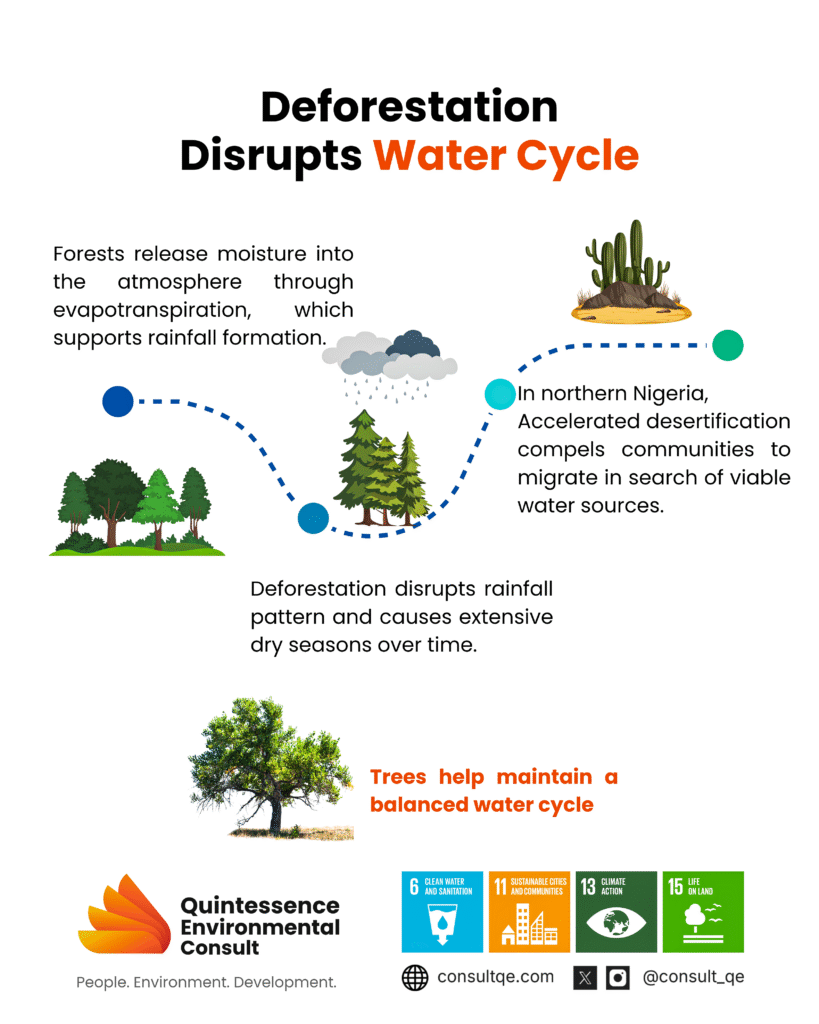
- Changing Rainfall Patterns and Water Scarcity
Forests play a pivotal role in regional climate regulation by releasing significant volumes of moisture into the atmosphere through evapotranspiration, which supports rainfall formation. Deforestation disrupts this intricate hydrological cycle, frequently leading to a reduction and alteration of rainfall seasons & precipitation patterns.(9) Northern Nigeria, in particular, has experienced extended dry seasons and accelerated desertification, compelling communities to migrate in search of viable water sources and productive land. In the northern Sahelian region, the combined effects of deforestation and climate change have diminished mean annual rainfall and transformed once fertile agricultural lands into arid landscapes. This water scarcity has triggered conflicts between farmers and herders competing for dwindling water resources, resulting in the loss of livelihoods and increased social tension.
PRINCIPAL DRIVERS OF DEFORESTATION IN NIGERIA
The drivers of deforestation in Nigeria are complex, rooted in socio-economic pressures and systemic challenges:
- Agricultural Expansion: The dominant driver remains the conversion of forestland for subsistence and commercial agriculture, driven by food security demands and the pursuit of cash crops (7).
- Unsustainable Logging and Fuelwood Extraction: High demand for timber, poles, and fuelwood, especially for domestic energy, is leading to unsustainable logging and forest clearing in many areas.This over-extraction of wood resources is driven by lack of access to alternative energy sources(17).
- Infrastructure Development and Urbanization: Rapid population growth and expanding urban areas necessitate increased infrastructure development, which often leads to the conversion of forested land for housing, roads, and industrial zones.
- Poverty and Lack of Alternative Livelihoods: Rural communities heavily reliant on forest resources often engage in unsustainable practices due to limited economic opportunities and food insecurity. This can include over-harvesting firewood, timber, and other products, as well as engaging in activities like unregulated hunting or slash-and-burn agriculture. These practices, driven by the need for immediate survival, can lead to deforestation, biodiversity loss, and a cycle of further environmental degradation, impacting the long-term availability of resources for these communities. (2).
- Weak Governance and Enforcement: Inadequate implementation of environmental policies, allows illicit activities such as and uncontrolled exploitation of forest resources (10).
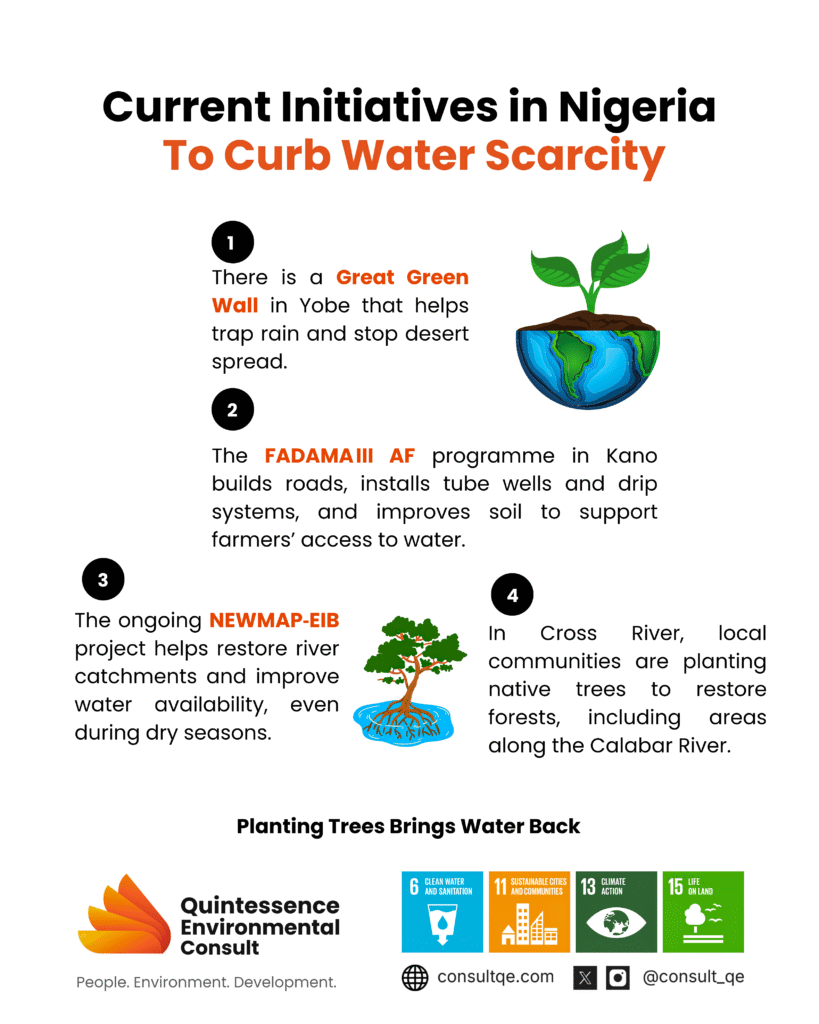
PATHWAYS TO WATER SECURITY
Addressing Nigeria’s water scarcity caused by deforestation requires a, multi-pronged approach centered on sustainable forest management and integrated water resource strategies.
1. Reforestation and Afforestation Initiatives
Large-scale tree planting and forest restoration projects are paramount. Initiatives like the Great Green Wall in Yobe State, aimed at combating desertification in the Sahel region, demonstrate the potential for ecological restoration to improve soil health, enhance water infiltration, and contribute to localized climate amelioration (16). Similarly, community-based reforestation projects, such as in Cross River State, where the local communities, in partnership with non-governmental organizations and conservation agencies, are actively engaged in restoring degraded forest ecosystems within the critical catchment areas of rivers like the Calabar River. (6) These efforts aim to revive water flow and improve access to clean water. In the Afi Mountain area, villagers planted native tree species, and after a few years, rivers that were once dry began to flow again, providing water for drinking and farming. (4)These initiatives also promote extensive tree planting, soil and water conservation techniques, enhancing rainwater harvesting and erosion control.
2. Sustainable Land Management and Agroforestry
The Fadama Projects, with significant support from the World Bank, actively promote the adoption of agroforestry systems. This sustainable land management practice strategically integrates tree cultivation with agricultural farming, providing multiple ecosystem services. (18)Farmers participating in these projects incorporate tree species to mitigate soil erosion, enhance soil organic matter, and significantly augment the water-holding capacity of the land.
3. Nigerian Erosion and Watershed Management Project (NEWMAP)
The NEWMAP project focuses on tackling erosion by restoring forests and stabilizing gullies. This initiative helps protect river catchments, ensuring a steady supply of water even during dry periods. NEWMAP has successfully restored significant sections of landscapes in Anambra State, where extensive gully erosion threatened human settlements and agricultural lands. The newly planted trees now help retain water in the soil and prevent further erosion. (17)
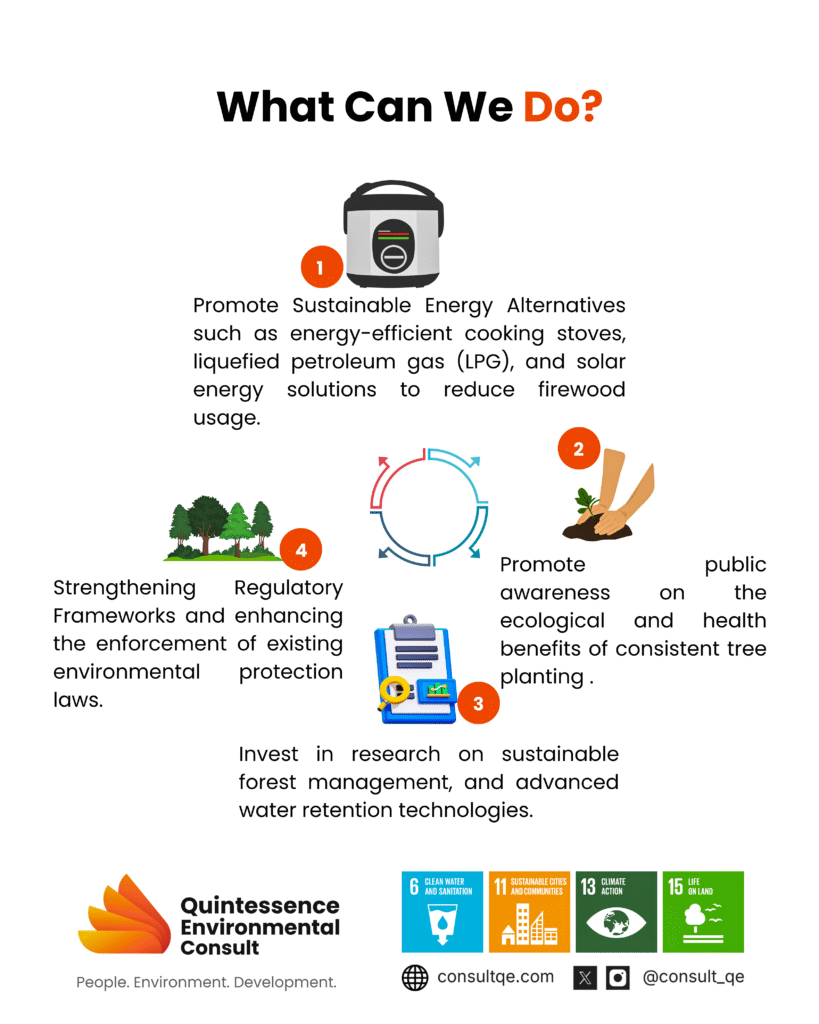
RECOMMENDATIONS AND FUTURE DIRECTIONS
To further enhance national efforts against deforestation and water scarcity crisis, the following strategic recommendations are proposed:
- Promotion of Sustainable Energy Alternatives: Prioritizing the provision of rural communities with access to energy-efficient cooking stoves, liquefied petroleum gas (LPG), and solar energy solutions can significantly reduce their dependence on traditional fuelwood. This shift is paramount for alleviating pressure on forest ecosystems, which are intrinsically linked to the maintenance of stable and sustainable water supplies.
- Investment in Applied Research and Development: Strategic investment in scientific research on sustainable forest management, advanced water retention technologies, and ecological restoration techniques tailored to Nigeria’s diverse agro-ecological zones is essential. Such investment would foster innovation in areas like climate-resilient agroforestry practices, advanced soil moisture conservation strategies, and efficient water use in agriculture.
- Strengthening Regulatory Frameworks and Enforcement: Robust implementation and stringent enforcement of existing environmental protection legislation, including laws against illegal logging, land encroachment, and unsustainable land-use practices, are crucial to deter further deforestation and degradation.
- Enhancement of Public Awareness and Education: Sustained and targeted public awareness campaigns are vital to educate all societal segments on the critical hydrological services provided by forests and the intrinsic link between forest health and long-term water security. This will foster a stronger sense of environmental stewardship and collective responsibility. (14)
CONCLUSION
Deforestation in Nigeria is indeed a critical issue with far-reaching consequences, extending beyond the immediate loss of trees to pose a significant threat to the nation’s water security and long-term sustainability. The removal of forests disrupts vital hydrological cycles, leading to reduced rainfall, increased soil erosion, and decreased water quality, all of which negatively impact water availability and access for communities and ecosystems. However, the concerted efforts in reforestation offer a tangible and promising pathway toward achieving water sustainability.
It’s time to recognize the connection between forests and water and take meaningful steps to protect them both. The proactive conservation and restoration of our forests will sustain our rivers, lakes, and streams that underpin all life and socio-economic development in Nigeria.
REFERENCES
- ADEOGUN, A.G. et al. (2023) ‘Modelling the impacts of selected watershed management strategies on sediment reduction upstream of Shiroro Dam, Nigeria’, Journal of Engineering Studies and Research, 28(4), pp. 7–17. doi:10.29081/jesr.v28i4.001.
- Angelsen, A. (2007). Forest livelihoods and deforestation: the policy context. Forest Policy and Economics, 9(5), 707-712.
- Bruijnzeel, L. A. (2004). Hydrological functions of tropical forests: not just a simple sponge. Water Resources Development, 20(1), 5-38.
- Duru, C.I., Chima, U.D. and Fredrick, C. (2025) ‘Assessment of Land Use and land cover changes in Afi River Forest Reserve Cross River State, Nigeria’, Journal of Agroforestry and Environment, 17(2), pp. 223–233. doi:10.55706/jae1738.
- Ellison, D., et al. (2017). Forests and water: From hydrology to human well-being. Science, 356(6335), 239-242.
- Essien Offiong, E. (2016) ‘Environmental degradation and conservation in the Cross River area: A historical appraisal of colonial and post colonial interventions’, PEOPLE: International Journal of Social Sciences, 2(1), pp. 607–621. doi:10.20319/pijss.2016.s21.607621.
- FAO. (2020). Global Forest Resources Assessment 2020: Main Report. Rome: Food and Agriculture Organization of the United Nations.

[…] https://www.consultqe.com/deforestation-a-critical-threat-to-sustainable-water-resources/ […]